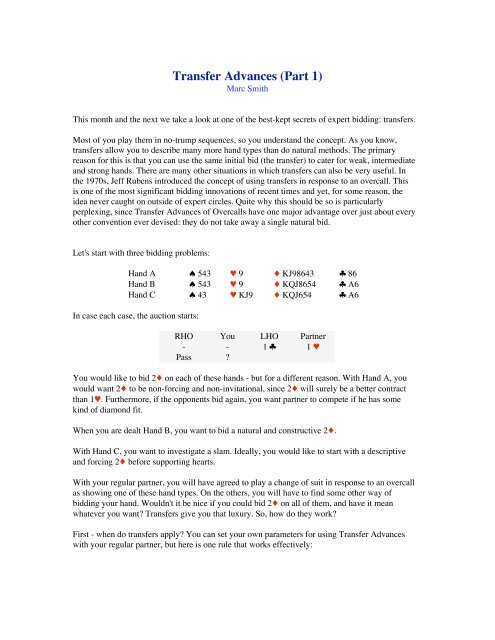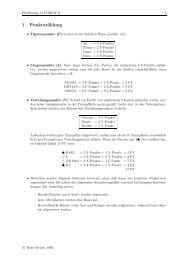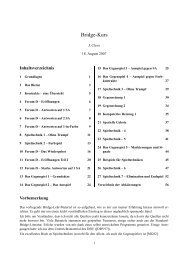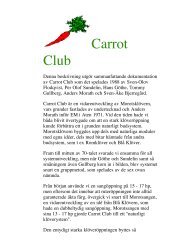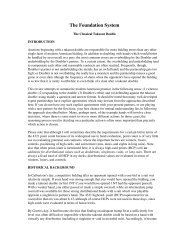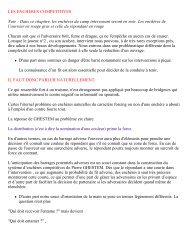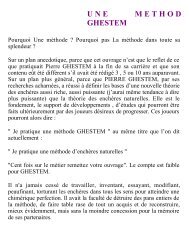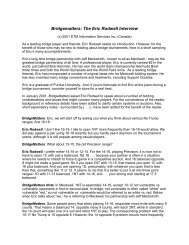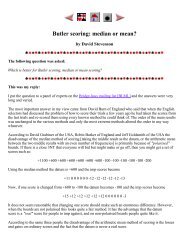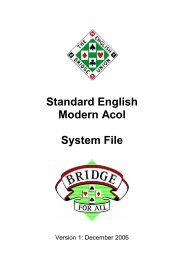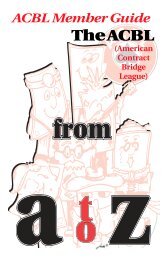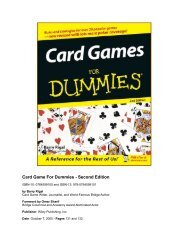Transfer Advances (Part 1) - Bridge Guys
Transfer Advances (Part 1) - Bridge Guys
Transfer Advances (Part 1) - Bridge Guys
Create successful ePaper yourself
Turn your PDF publications into a flip-book with our unique Google optimized e-Paper software.
<strong>Transfer</strong> <strong>Advances</strong> (<strong>Part</strong> 1)<br />
Marc Smith<br />
This month and the next we take a look at one of the best-kept secrets of expert bidding: transfers.<br />
Most of you play them in no-trump sequences, so you understand the concept. As you know,<br />
transfers allow you to describe many more hand types than do natural methods. The primary<br />
reason for this is that you can use the same initial bid (the transfer) to cater for weak, intermediate<br />
and strong hands. There are many other situations in which transfers can also be very useful. In<br />
the 1970s, Jeff Rubens introduced the concept of using transfers in response to an overcall. This<br />
is one of the most significant bidding innovations of recent times and yet, for some reason, the<br />
idea never caught on outside of expert circles. Quite why this should be so is particularly<br />
perplexing, since <strong>Transfer</strong> <strong>Advances</strong> of Overcalls have one major advantage over just about every<br />
other convention ever devised: they do not take away a single natural bid.<br />
Let's start with three bidding problems:<br />
Hand A 543 © 9 ® KJ98643 ß 86<br />
Hand B 543 © 9 ® KQJ8654 ß A6<br />
Hand C 43 © KJ9 ® KQJ654 ß A6<br />
In case each case, the auction starts:<br />
RHO You LHO <strong>Part</strong>ner<br />
- - 1 ß 1 ©<br />
Pass ?<br />
You would like to bid 2® on each of these hands - but for a different reason. With Hand A, you<br />
would want 2® to be non-forcing and non-invitational, since 2® will surely be a better contract<br />
than 1©. Furthermore, if the opponents bid again, you want partner to compete if he has some<br />
kind of diamond fit.<br />
When you are dealt Hand B, you want to bid a natural and constructive 2®.<br />
With Hand C, you want to investigate a slam. Ideally, you would like to start with a descriptive<br />
and forcing 2® before supporting hearts.<br />
With your regular partner, you will have agreed to play a change of suit in response to an overcall<br />
as showing one of these hand types. On the others, you will have to find some other way of<br />
bidding your hand. Wouldn't it be nice if you could bid 2® on all of them, and have it mean<br />
whatever you want? <strong>Transfer</strong>s give you that luxury. So, how do they work?<br />
First - when do transfers apply? You can set your own parameters for using <strong>Transfer</strong> <strong>Advances</strong><br />
with your regular partner, but here is one rule that works effectively:
<strong>Transfer</strong> <strong>Advances</strong> apply after any second-seat non-jump suit overcall at the one, two or three<br />
level.<br />
Next, which bids become transfers? Here is the basic premise:<br />
Bids between a simple cue-bid and a simple raise are conventional (rotated).<br />
Thus, a transfer into overcaller's suit now becomes the sound raise. (If this sounds obscure, do not<br />
give up - yet!)<br />
Other bids are unaffected, but here is a sound set of principles that works effectively:<br />
o Bids in other suits are natural and forcing<br />
o Bids of NT are natural<br />
o Raises of overcaller's suit are always pre-emptive<br />
o Jumps in new suits are fit-showing<br />
o Jumps in opener's suit are splinters<br />
Many of you will already follow some variation of these, but I have included them here for the<br />
sake of completeness.<br />
The basic concept of the <strong>Transfer</strong> Advance is that you rotate the meaning of all bids between and<br />
including the simple cue-bid to the bid below the raise. That may sound complicated, but a couple<br />
of examples should make it clear. Let's say the auction begins:<br />
RHO You LHO <strong>Part</strong>ner - - 1© 1 Pass ?<br />
Most pairs would use a bid of 2© as a sound spade raise and 2 as a weak raise. Playing <strong>Transfer</strong><br />
<strong>Advances</strong> does not change this at all, because there are no bids between the cue-bid (2©) and the<br />
bid below a raise (2©).<br />
Now, let's change the auction slightly RHO You LHO <strong>Part</strong>ner - - 1® 1 Pass ?<br />
Now there are two relevant bids: 2® and 2©. Playing standard methods, 2® would show a sound<br />
spade raise and 2© would be natural and either weak, constructive, or forcing depending on your<br />
preference. Playing <strong>Transfer</strong> <strong>Advances</strong>, you simply switch the meaning of those two bids.<br />
Thus: RHO You LHO <strong>Part</strong>ner 1® 1 Pass 2®<br />
This 2® bid is now a transfer to hearts. (We will see later how the auction continues.)<br />
RHO You LHO <strong>Part</strong>ner 1® 1 Pass 2©<br />
This is now the sound spade raise. Think of the 2© bid as a transfer to spades.<br />
Now let's look at the auction with the most space between the bid suits:�<br />
RHO You LHO <strong>Part</strong>ner 1ß 1 Pass ?
In standard methods, 2® and 2© would be natural and 2 would be used to show the sound spade<br />
raise. Rotating these bids, 2 becomes a transfer to diamonds, 2® a transfer to hearts, and 2© a<br />
transfer to spades (i.e. the sound raise).<br />
Notice that no natural bids have been lost: any hand that you could show with your current<br />
methods can still be shown, albeit via a different route.<br />
This structure works equally well to give you much-needed extra space at higher levels:�<br />
RHO You LHO <strong>Part</strong>ner - - 2©* 3ß Pass ?*<br />
Weak two<br />
Using <strong>Transfer</strong> <strong>Advances</strong>:3® = natural and forcing 3© = transfer to spades 3 = good hand with<br />
a club fit<br />
And even higher: RHO You LHO <strong>Part</strong>ner 3ß 3 Pass ?<br />
3NT = natural<br />
4ß = at least five diamonds<br />
4® = at least five hearts<br />
4© = slam try in spades<br />
4 = normal raise<br />
<strong>Transfer</strong> <strong>Advances</strong> (<strong>Part</strong> 2)<br />
Marc Smith<br />
Last month, we saw how you can use transfers to increase your options when responding to<br />
partner's overcall. This month we take a look at how the auction continues and consider some<br />
deals illustrating the method in action.<br />
To recap, we established last month that transfers could be used by switching the meaning of the<br />
bids between a cue-bid raise and the bid immediately below a simple raise. Thus:<br />
Standard methods:<br />
RHO You LHO <strong>Part</strong>ner<br />
1ß 1<br />
Pass ?<br />
2ß Sound spade raise<br />
2® Natural (weak, invitational or forcing - choose one only)<br />
2© Natural (weak, invitational or forcing - choose one only)<br />
2 Competitive-only raise
Using <strong>Transfer</strong> <strong>Advances</strong>:<br />
2ß <strong>Transfer</strong> to diamonds (may be weak, invitational or strong, with or without a spade fit)<br />
2® <strong>Transfer</strong> to hearts (may be weak, invitational or strong, with or without a spade fit)<br />
2© <strong>Transfer</strong> to spades (sound spade raise)<br />
2 Competitive-only raise<br />
Note: Any hands that you could have shown using standard methods can still be shown using<br />
transfers.<br />
The advantage is that so too can many of the hand types that could not be described using<br />
standard methods.<br />
OK, so how does partner respond to your transfer? In most cases, he simply accepts the transfer.<br />
RHO You LHO <strong>Part</strong>ner<br />
1ß 1<br />
Pass 2ß* Pass 2®<br />
<strong>Part</strong>ner should always remember that you might have a very weak hand - something like:<br />
4 © Q72 ® KJ107642 ß 95<br />
Which do you think would be a better contract: 1 or 2®? You will be wrong occasionally, but<br />
I'll bet you voted for 2®.<br />
<strong>Part</strong>ner's simple acceptance of the transfer is neutral and suggests that he would have passed a<br />
non-forcing bid in the suit. This allows you to correct the contract when you hold a weakish hand<br />
with a long suit and no fit for partner's overcall. <strong>Part</strong>ner is allowed to rebid his own suit (with a<br />
good six-card suit but usually longer and no fit for your suit). This does not show extra values:<br />
RHO You LHO <strong>Part</strong>ner<br />
1ß 1<br />
Pass 2ß* Pass 2<br />
AK652 © 76 ® K863 ß J5<br />
If your RHO has a weak hand with five or six hearts, he is quite likely to take the opportunity to<br />
show his suit if your partner simply bids 2®. The pre-emptive jump may shut out the enemy's<br />
best suit. Again, this jump does not show extra high-card values. If you now return to partner's<br />
suit, this is non-forcing, but you have shown an invitational raise with values in the suit to which<br />
you transferred.<br />
A bid of the fourth suit is natural and shows extra values.<br />
RHO You LHO <strong>Part</strong>ner<br />
1ß 1<br />
Pass 2ß* Pass 2©
<strong>Part</strong>ner will often be 5-5, but may be 5-4-3-1 with a three-card fit for your suit.<br />
A cue-bid, as in the auction below:<br />
shows a good hand with a fit for your suit.<br />
RHO You LHO <strong>Part</strong>ner<br />
1ß 1<br />
Pass 2ß* Pass 3ß<br />
2NT is natural with extra values and usually doubleton support for your suit. With a weak hand<br />
and a long suit, you can now repeat (bid) your suit and partner will pass. Thus:<br />
RHO You LHO <strong>Part</strong>ner<br />
1ß 1<br />
Pass 2ß* Pass 2NT<br />
Pass 3® End<br />
It is when you intend to bid on after transferring that the method offers the greatest flexibility.<br />
Assuming partner makes the neutral transfer-completion response, you can now describe your<br />
hand much more accurately than standard methods allow. Let's use the following auction as an<br />
example:<br />
RHO You LHO <strong>Part</strong>ner<br />
1ß 1© Pass<br />
2ß* Pass 2® Pass<br />
?<br />
2© A sound three-card heart raise with diamond values/length<br />
e.g. J73 © J85 ® AQ1054 ß Q5<br />
2 Natural reverse,<br />
e.g. AQ105 © 94 ® AQ1054 ß 92<br />
2NT Natural and invitational,<br />
e.g. K84 © 93 ® AQJ83 ß K106<br />
3ß STOP-ASKING,<br />
e.g. A95 © 83 ® AKQ1086 ß 96<br />
3® Invitational,<br />
e.g. 543 © 9 ® KQJ9654 ß A8<br />
3© Invitational three-card heart raise with diamond values.<br />
e.g. J65 © A85 ® AQ1076 ß Q9<br />
3 Splinter with hearts support,<br />
e.g. 8 © A96 ® AQJ975 ß K109
Let's finish by looking at a few complete auctions. In each case, you are sitting West.<br />
J73<br />
© J85<br />
® AQ1054<br />
ß Q5<br />
N<br />
W E<br />
S<br />
You LHO <strong>Part</strong>ner RHO<br />
1ß 1© Pass<br />
2ß* Pass 2® Pass<br />
2© End<br />
A85<br />
© AQ764<br />
® 9<br />
ß K863<br />
You have shown a constructive heart raise with length/values in diamonds. With a misfitting<br />
hand, partner has an easy pass despite having some extra high cards to spare. By contrast:<br />
A73<br />
© J85<br />
® AQ1054<br />
ß Q5<br />
N<br />
W E<br />
S<br />
You LHO <strong>Part</strong>ner RHO<br />
1ß 1© Pass<br />
2ß* Pass 2® Pass<br />
3© Pass 4© End<br />
A<br />
© AQ764<br />
® K96<br />
ß 8643<br />
The auction begins in the same way but, with a diamond fit and a non-minimum overcall, partner<br />
bids game confidently.<br />
543<br />
© 9<br />
® KQJ9654<br />
ß A8<br />
N<br />
W E<br />
S<br />
You LHO <strong>Part</strong>ner RHO<br />
1ß 1© Pass<br />
2ß* Pass 2® Pass<br />
3® Pass 3NT End<br />
QJ7<br />
© A10875<br />
® 10<br />
ß K1054<br />
On the lay-out above, you transfer and then raise yourself to show an invitational hand with very<br />
good diamonds. With stops in the other two suits, partner takes a reasonable shot at game.
73<br />
© KJ9<br />
® KQJ654<br />
ß A6<br />
N<br />
W E<br />
S<br />
You LHO <strong>Part</strong>ner RHO<br />
1ß 1© Pass<br />
2ß* Pass 2® Pass<br />
4ß Pass 4® Pass<br />
4© Pass 4 Pass<br />
4NT Pass 5 Pass<br />
6® End<br />
K65<br />
© AQ1076<br />
® A7<br />
ß 974<br />
This time, you transfer to diamonds and then jump to 4ß, showing slam interest with good<br />
diamonds, a heart fit and a club control (remember that 3ß would be forcing). Opposite a slam<br />
try, partner's hand looks good. Once he shows a spade control, you can take over with Blackwood<br />
and bid the excellent slam.<br />
When electing to add a new toy to your system, you must always remember to discuss situations<br />
that may arise. For example, suppose opener's partner does not pass. Do transfers still apply? My<br />
suggestion is that they should do so if LHO's bid is below a raise of opener's suit (i.e. if the bid<br />
does not remove one of your artificial bids). What if responder makes a negative double? Then<br />
you can play that a Redouble is a lead-directing raise (a la Rosencrantz) showing a top honour in<br />
the overcaller's, suit while a simple raise denies one. (The transfer-raise says nothing about a top<br />
honour.) If third hand bids a new suit below a raise, then Double can still be used as a normal<br />
responsive double, showing the fourth suit and at least tolerance for partner's overcall.<br />
If opener's partner raises or bids anything higher, then all transfer advances are off and you bid as<br />
you would using standard methods.


